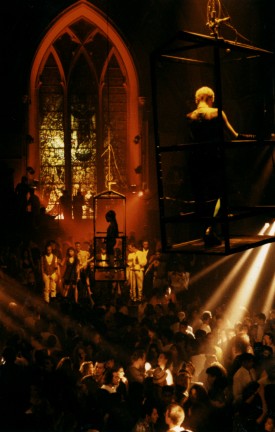‘Limelight’ recreates the 1990s clubbing scene in NYC

Limelight, the legendary nightclub-within-a-church that rocked New York City for nearly two decades, has closed its doors and become a victim of the gentrification that has swept the Big Apple far and wide. Traveling past the old Episcopal Church in 2012 doesn’t quite conjure images of the early days of raves, techno music and alternative culture. Instead, there are depictions of Starbucks and mommies pushing strollers. Peter Gatien, owner of the Limelight and three other clubs in New York City, must be reeling to know that his presence is no longer a reality in Manhattan, just a legacy, and a sad one at that.
Limelight, a new documentary directed by Billy Corben and produced by Gatien’s daughter, tries to recreate the clubland scene. The 102-minute film only intermittently achieves its goals.
The documentary smartly follows the turbulent trajectory of Gatien from his childhood in Canada to his early days as a club owner in Miami and Atlanta. The man, who wears either dark sunglasses or an eyepatch because of a childhood accident, is a cool-cat iconoclast, a man who opened the door for tens of thousands of partying youngsters.
According to the documentary, there wasn’t much to the madness of Gatien’s scheme; he simply had the ambitions at the right time and in the right place. New York City, on the eve of the AIDS epidemic and at the height of the disco era, was yearning for a place to bump, grind and stay up all night. The Limelight, which opened within the confines of an abandoned church in Chelsea, served that purpose and then some. The venue became world famous for its weekly parade of celebrities, oddball fashion statements and rampant drug use. Studio 54 was a thing of the past; the Limelight was its bastard, head-bopping, body-sweating, cross-dressing, pill-popping son. Every type of person partied at the Limelight and Gatien’s other clubs, including the Tunnel, Palladium and Club USA. From Staten Island Italians to African-Americans from the outer boroughs, Gatien invited everyone to party in Manhattan until the early hours of the morning.

Of course, to attract the crowds, the club owner hired a full suite of promoters to drum up business and exploit certain niche markets. Sunday nights became hip-hop night, and the likes of Jay-Z, 50 Cent and Snoop Doog were present. Other nights were focused on techno, while others featured the early work of such musicians as Moby and The Beastie Boys.
The music filled the air, while the drugs were passed from person to person. The documentary takes a strange stance on the drug use at Limelight. At first, it describes a scene of pill-popping, cocaine-snorting debauchery. Through a series of talking-head interviews with former partygoers, the portrait is one of near-hallucogenic craziness. But then the film changes in tone when describing the New York Police Department, during the administration of then-Mayor Rudolph Giuliani, and its crackdown on “quality-of-life” crimes. All of a sudden, the documentary and its subjects become somewhat naive about the drug use at Limelight, trying to cast Gatien’s establishment as more wholesome than it probably ever was.
It didn’t take long for the clubs to shut down by police order, and Gatien to be hauled off in handcuffs. The charges were that the club owner enabled drug use in his venues and also turned a profit from the sale of Ecstasy. Gatien, in the documentary and at the time of the arrests, vehemently denied the charges, claiming he shouldn’t be held responsible for a few bad apples in a crowd that sometimes swelled to more than 10,000 per week. The evidence stacked against Gatien, including unreliable testimony from former drug dealers facing their own criminal charges, was certainly weak and bordering on insane. But still, it went to trial and the club owner hired one of the best criminal defense attorneys in town to fight for his life.
While Gatien defended himself over several years, his clubs fell by the wayside. They were either shut down, sold or became the victim of such intense security that the free-loving vibe quickly died. With all the legal fees he was paying and the loss of income, Gatien went from the heights of the social scene all the way down to its darkest depths.
Limelight tries too hard in its rehashing of all the facts. At first, it begins as a documentary on the Limelight itself, and then Gatien’s legal trouble hijacks the plot and takes center stage. The talking heads — including Moby and notorious “Club Kid” Michael Alig — all provide interesting thoughts and perspectives, but it’s difficult to go from one interview to another in such quick succession. After a while, the audience becomes bogged down in talk, talk, talk, and with the Limelight being such a visual club, the discussions cheapen the overall story.
Still, there is no denying that Gatien’s tale is engaging and historic. He helped corral a segment of society that produced almost instantaneous controversy. Parents were upset about where their kids were heading dressed up in weird costumes on a Friday night, while the youngsters themselves felt liberated and accepted. Plus, Gatien’s clubland produced recognizable and successful talent. Moby, Madonna, The Beastie Boys, Jay-Z and 50 Cent didn’t just have a hit song or two; these are some of the top-selling musicians of all time, and they often used Gatien’s clubs as a baby pool to find their swimming legs.
The one thing that Limelight does accurately convey also turns out to be the film’s most obvious flaw: The club scene of the 1980s and 1990s was so unique and unconventional that it probably needed to be seen to be believed. Watching all the antics some 20 years later on a DVD only delivers half the hoopla.
By John Soltes / Publisher / John@HollywoodSoapbox.com
-
Limelight
-
2011
-
Directed by Billy Corben
-
Running time: 102 minutes
-
Not Rated
-
Rating:





